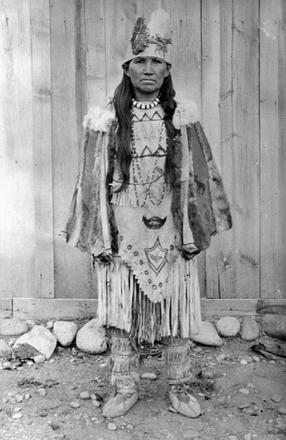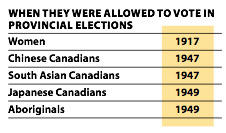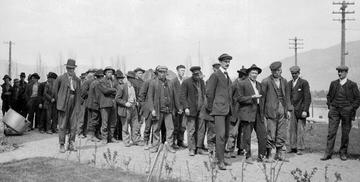Social Studies 7 to 9
Grade 7
The Ancient World to the 7th Century
Social, Political, Legal, Governmental, and Economic Systems and Structures, including at least one Indigenous to the Americas:
|
Sample activities:
|
Grade 8
7th Century to 1750
Assess the significance of people, places, events, or developments at particular times and places (significance):
Key questions:
- Which explorer had the greatest impact on the colonization of North America?

Alexander Mackenzie recording his arrival at the Pacific, 1793. Painting by John Innes. SFU & Native Sons of BC
Make ethical judgments about past events, decisions, or actions, and assess the limitations of drawing direct lessons from the past (ethical judgment):
Key questions:
- How are different groups represented in various cultural narratives?
- What lessons can we learn from the loss of languages due to imperialism?
Social, political, and economic systems and structures, including those of at least one indigenous civilization
Changes in population and living standards:
Sample topics:
- Forced and unforced migration and movement of people
- Diseases and health
- Aboriginal Demography
- Chapter 4 of Far West, Disease and Defiance
- Search for disease name, eg. Smallpox
Grade 9
1750 – 1919
Assess the significance of people, places, events, or developments, and compare varying perspectives on their historical significance at particular times and places, and from group to group (significance):
|
Sample activities:
|
Assess the justification for competing historical accounts after investigating points of contention, reliability of sources, and adequacy of evidence (evidence):
Key questions:
- What evidence is there that imperialism and colonialism still influence present-day relationships between countries and groups?
- First Nations of BC
- Chinese
- Chapter 7 of Far West, Treatment of Japanese

Posters like this one were put up in all coastal areas of BC in 1942. They warned Japanese Canadians that they were not allowed to remain on the coast.
- What evidence is there to support John A. Macdonald’s argument that BC would be better off joining the United States if the transcontinental railway was not built?
- Confederation
- Confederation League
- Chapter 4 of Far West, on Joining Canada

The waterfront at New Westminster in 1860. The ship is the Vickeray from San Francisco, the first vessel to load cargo at the little port. BC Archives B-06377
Compare and contrast continuities and changes for different groups at the same time period (continuity and change):
Key questions:
- Why did Baldwin and LaFontaine succeed where Mackenzie and Papineau failed?
- In what ways has the colonization of Canada made life better or worse? And for whom?
Imperialism and Colonialism, and their continuing effects on Indigenous Peoples in Canada and around the World:
Sample topics:
- impact of treaties on First Peoples (e.g., numbered treaties, Vancouver Island treaties)
- impact of the Indian Act, including reservations and the residential school system
- interactions between Europeans and First Peoples

Aboriginal people relied on the world around them to provide all their needs. This woman was a member of the Nlaka’pamux (Ing-khla-KAP-muh) people, who live along the Fraser River. All her clothing is made from animal skins, even her hat, which is decorated with bird feathers. Canadian Museum of Civilization 23212
Global Demographic shifts, including Patterns of Migration and Population Growth:
Sample topics:
- Slavery
- Disease, poverty, famine, and the search for land
- Aboriginal Demography in BC
- Chapter 4 of Far West, Disease and Defiance
- Search for disease name, eg. Influenza

A group of Aboriginal leaders at St. Mary’s Mission on the Fraser River, 1867. BC Archives O-09263
- Why immigrants (including East and South Asian immigrants) came to BC and Canada, the individual challenges they faced, and their contributions to BC and Canada
- Peoples of BC
- South Asians
- Komagata Maru
- Chinese and Chapter 12 of From the West Coast to the Western Front, The Chinese Labour Corps
- Head Tax
- Japanese
- Japanese Internment

Chinese businessmen in front of their New Westminster shop, 1895. VPL 8056
- Influences of immigration on Canada’s identity
- Historical reasons for the immigration of specific cultural groups to Canada (e.g., Irish potato famine, Chinese railway workforce, World War II refugees, underground railroad, Acadians, western settlement campaign, gold rushes)
Key questions:
- Did immigrants benefit from emigrating to Canada?
- How did the arrival of new groups of immigrants affect Canadian identity?
Nationalism and the Development of Modern Nation-States, including Canada:
Sample topics:
- Canadian Confederation
- Chapter 4 of Far West, Confederation
- Confederation

At the time of Confederation in 1871, British Columbia was a rough frontier outpost. Many of the residents had come from Britain and tried to create a small model of the mother country far from home. This fashionable group in Victoria has just enjoyed a game of lawn tennis. To this day, Victoria keeps some of its British flavour. BC Archives C-03924
- National projects and policies (e.g., the building of the Canadian Pacific Railway, Macdonald’s National Policy)

A Chinese work gang takes a rest from the backbreaking labour of building the railway, 1880s. Glenbow Archives NA3740-29
Local, Regional, and Global Conflicts:
Sample topics:
- Chilcotin War
- Fraser Canyon War
Discriminatory policies and injustices in Canada and the World, such as the Head Tax, the Komagata Maru Incident, Residential Schools, and
World War I Internment:
Sample topics:
- Head Tax and other discriminatory immigration policies against people of East and South Asian descent
- Chapter 6 of Far West, Asian Newcomers
- South Asians
- Komagata Maru
- Chinese
- Head tax
- Japanese
- Japanese Internment
- Chapter 7 of Far West, Treatment of the Japanese

Above: From 1914 to 1941, the Asahi (a Japanese word meaning “morning sun”) was one of the best baseball teams in Vancouver. It was the pride of the Japanese community. All the best players wanted to belong. The team disbanded when most of the players were sent away from the coast during World War II. Sanmiya Family Collection. Japanese Canadian National Museum 94/41.018
- Societal attitudes toward ethnic minorities in Canada (e.g., Chinese railway workers, Sikh loggers, Eastern European farmers, Irish famine refugees, African American slavery refugees)
- Discriminatory policies toward First Peoples, such as the Indian Act, potlatch ban, residential schools
- Chapter 1 of Far West, on Original People
- First Nations of BC
- Aboriginal Rights
- Aboriginal Demography
- Potlatch
- Chapter 1 of Far West, Potlatch
- Residential Schools
- Japanese internment http://knowbc.com/books/Encyclopedia-of-BC/J/Japanese-Relocation-of and http://knowbc.com/books/Far-West/Chapter-7-Hard-Times-and-War#treatmentofthejapanese
- Social history
- Gender issues
- Suffrage
- Chapter 4 of Far West, Who could vote
- Japanese
- Sikh
- Doukhobors and Chapter 8 of Far West, The Doukhobors
- First Nations of BC
- Chinese
- South Asians

- Labour history, workers’ rights
- Chapter 3 of On the Line, A New Century and New Labour Awareness
- BC Labour Movement

A large group of strikers is arrested near Savona in April 1912 during the battle by IWW railway construction workers against the Canadian Northern Railway. Their only crime seemed to have been their effrontery in going on strike. Image E-00230, Royal BC Museum and Archives.
- Responses to discrimination in Canada
- Asiatic Exclusion League in BC
- discrimination against German Canadians during World War I
Key question:
- How might specific examples of past incidents of inequality (e.g., Head Tax on Chinese immigrants, internment of Japanese Canadians, residential schools, suffrage, discriminatory federal government labour practices related to gender and sexual orientation) be handled today under the Canadian Charter of Rights and Freedoms?
Physiographic Features and Natural Resources in Canada:
Sample topic:
- Connections between Canada’s natural resources and major economic activities
- Economy of BC
- Chapter 5 of Far West, Resources and the Economy

This painting shows the Canadian Pacific wharf on the Vancouver waterfront on a busy day in 1887. A freight train is arriving from Eastern Canada. So is a coastal steamboat, bringing mail and passengers from Victoria. Gordon Miller painting
|
Sample activities:
|
Key questions:
- What effect has the physical geography of Canada had on Canadian and regional identity?
- What perspectives do different groups (e.g., environmental groups, people employed in the forest industry, First Peoples, urban and rural populations) have on the use of natural resources?
